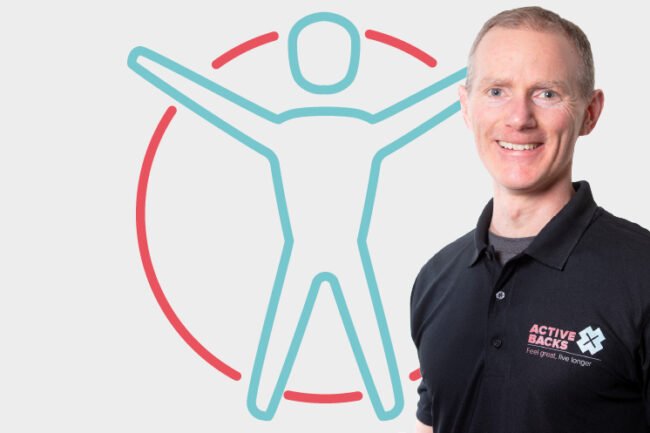The best exercises for sciatica
The best exercises for sciatica
This episode is entitled “The best exercises for sciatica”, and you will learn:
- The two types of sciatica
- How to determine which type of sciatica you have
- What matters most when deciding the best exercises for sciatica
- What can make it more complicated

The two types of sciatica
One type is nerve compression sciatica, where one of the nerves is being compressed or irritated. The most common cause of this is a disc problem, either at L4, L5, or L5S1. Your L4, L5, S1 and S2 nerve roots all joined together, deepen your pelvis to form your sciatic nerve, which then exits the sciatic notch.
The other type is non nerve compression sciatica. Here you can have pain, or pins and needles in the distribution of your sciatic nerve without direct irritation or compression of one of those aforementioned nerves. The mechanism is referred pain. Let’s say you’ve strained a muscle in your buttock. But the original nerve supply to that buttock muscle is L5. Then you could manifest experience pain anywhere in the distribution of your L5 nerve root that is referred pain. An L5 covers quite a broad area from the button all the way down the outside, back of your thigh, down into the calf and onto the top of the foot. You could have sciatic radiation in that distribution without actual nerve compression or irritation.
How to determine which type of sciatica you have
If your pain below your knee is worse than the pain above your knee, or you have raging pains and needles or weakness in any of your muscle groups, you probably have nerve compression sciatica. In the absense of all of those, it’s more likely to be non nerve compression sciatica. That’s a generalization. For instance, the ability to lift your big toe up, or the ability to go up on to the toes on that foot. To lift your heel off the ground, then these are motor signs. It’s likely that you have nerve compression in these different scenarios. There’s a lot of tests that we as clinicians would do to you, including testing your muscle power reflexes sensation, etc.
What matters most when deciding the best exercises for sciatica
It all depends on what makes your pain worse. If your pain is increased by bending forwards, avoid that motion and do exercises that involve arching your back backwards, like standing with your hands on the small of your back and arching backwards, or on all fours, lifting your head and your tail up. Also lying on your front, perhaps coming up onto your forearms. March your forearms forward so that you’re in that kind of Sphinx position. That would allow your back to sink into that arch. These exercises tend to relieve your pain if your pain in your leg is aggravated by bending forwards.
If your pain is worse bending backwards, you will benefit from exercises that involve bending or curling your back forwards. On all fours, arching your back up in the air. As you tuck your pelvis and head down, possibly even lying on your back, curling your knees up towards your chest that may ease your pain.
There are other exercises for sciatica that are very movement dependent, like the wall lean. If you have right-sided sciatica pain, stand at arms length from the wall, put your right hand on the wall and keeping a straight elbow, take your right foot off the floor and cross it over the left one. Gently lean your right hip towards the wall. If this is painful don’t do it. Lean your head towards the wall as far as you can. Then just a gentle bounce, like moving through a five millimeter range of motion about eight times, then bring your hips up to level. Push away from the wall, give everything a bit, shake down. Then repeat it. Some people with pain on the right leg are better doing the wall lean the opposite way, to the left. It’s uncommon, but certainly worth trying.
Another one is sciatic flossing. The idea is to minimize the risk that one of your nerve roots or the sciatic nerve becomes tethered by scar tissue. If you have a disc problem, the whole area of where the nerve exits from the spinal column and where the disc is irritating can become gungy, fibrotic and yucky. That limits the motion of the nerve through the halls. As you’re moving around your back, your nerves, your muscles, the nerve isn’t static in the hall. We’re trying to move the nerve in and out of the hall. The proximal end is attached to your spinal cord. Then it continues out into the periphery all the way down your leg towards the big toe. We want to floss that section of nerve that is coming through exiting the spine.
Sit perch on a higher surface, ideally higher up than that perch on the edge. Lift the leg with a straight knee up towards you bending at the hip as you drop your head backwards. As the head goes back, the straight leg comes up, ideally with your big toe pulled up towards you. If you get pain down your leg, back off. Tilt your head backwards before you start to lift the leg up. That way you’re taking the sciatic nerve and your whole spinal cord off stretch. As you bend the knee and relax back down again, bend your head forwards. You’re stretching the spinal cord at the top and taking the sciatic nerve off stretch at the bottom. Head goes forward, bend the knee. Repeat that motion 10 times, nice and slowly, in a way that doesn’t aggravate your pain.
What can make it more complicated
When it comes to disc problems (prolapsed, lumbar, herniated discs, the disc itself), it’s not just about easing the nerve related to pain, but also about not aggravating it. If you have a tear at the back of your disc, it has to heal by the formation of scar tissue. While that happens, don’t stretch that tissue. Don’t bend forwards or stretch the back of the disc for the first few weeks. The central two thirds of your disc is insensate, so you can damage it without any pain. The following morning, the pain will be worse because you’ve, re-established an acute inflammatory response, which is the body’s natural response to any tissue damage that inflammation will aggravate the nerve and you’ll have more sciatica.
Get input from someone who specializes in exercises for sciatica, as we do. Go to Active-x.co.uk. You can have an online consultation about this via Skype, or come and see us in person in Edinburgh. Either way, the disc takes many weeks to heal, and during that time you don’t want to be picking the scab and tearing the tissue while it’s still in its infancy. That can make it a little bit more complicated than just going in the opposite direction to pain.


